High-Quality GaSe Single Crystal Grown by the Bridgman Method
Abstract
:1. Introduction
2. Experimental Section
2.1. Synthesis of GaSe Polycrystals
2.2. Growth of Single-Crystal GaSe
2.3. Characterization Methods
2.4. The Preparation of GaSe (Metal-Oxide Semiconductor Field-Effect Transistor) MOSFET Photodetector
3. Results and Discussion
3.1. Crystalline Structure and Composition
3.2. Optical Measurements
3.3. Electrical Measurements
3.4. Characterization of the Few-Layered GaSe Photodetector
4. Conclusions
Supplementary Materials
Acknowledgments
Author Contributions
Conflicts of Interest
References
- Abdullaev, G.B.; Kulevskii, L.A.; Prokhorov, A.M.; Savel’Ev, A.D.; Salaev, E.Y.; Smirnov, V.V. GaSe, A New Effective Material for Nonlinear Optics. J. Exp. Theor. Phys. Lett. 1972, 16, 90. [Google Scholar]
- Kador, L.; Haarer, D.; Allakhverdiev, K.R.; Salaev, E.Y. Phase-matched second-harmonic generation at 789.5 nm in a GaSe crystal. Appl. Phys. Lett. 1996, 69, 731–733. [Google Scholar] [CrossRef]
- Shi, W.; Ding, Y.J. A monochromatic and high-power terahertz source tunable in the ranges of 2.7–38.4 and 58.2–3540 μm for variety of potential applications. Appl. Phys. Lett. 2004, 84, 1635–1637. [Google Scholar] [CrossRef]
- Ding, Y.J.; Shi, W. Widely tunable monochromatic THz sources based on phase-matched difference-frequency generation in nonlinear-optical crystals: A novel approach. Laser Phys. 2006, 16, 562–570. [Google Scholar] [CrossRef]
- Shi, W.E.I.; Ding, Y.J. Tunable Coherent Radiation from Terahertz to Microwave by Mixing Two Infrared Frequencies in a 47 mm long GaSe Crystal. Int. J. High Speed Electron. Syst. 2006, 16, 589–595. [Google Scholar] [CrossRef]
- Feng, Z.; Kang, Z.; Wu, F.; Gao, J.; Jiang, Y.; Zhang, H.; Andreev, Y.; Lanskii, G.; Atuchin, V.; Gavrilova, T. SHG in doped GaSe:In crystals. Opt. Express 2008, 16, 9978–9985. [Google Scholar] [CrossRef] [PubMed]
- Kang, Z.-H.; Guo, J.; Feng, Z.-S.; Gao, J.-Y.; Xie, J.-J.; Zhang, L.-M.; Atuchin, V.; Andreev, Y.; Lanskii, G.; Shaiduko, A. Tellurium and sulfur doped GaSe for mid-IR applications. Appl. Phys. B 2012, 108, 545–552. [Google Scholar] [CrossRef]
- Bereznaya, S.; Korotchenko, Z.; Redkin, R.; Sarkisov, S.; Tolbanov, O.; Trukhin, V.; Gorlenko, N.; Sarkisov, Y.; Atuchin, V. Broadband and narrowband terahertz generation and detection in GaSe1−xSx crystals. J. Opt. 2017, 19, 115503. [Google Scholar] [CrossRef]
- Hu, P.A.; Wen, Z.; Wang, L.; Tan, P.; Xiao, K. Synthesis of Few-Layer GaSe Nanosheets for High Performance Photodetectors. ACS Nano 2012, 6, 5988–5994. [Google Scholar] [CrossRef] [PubMed]
- Cao, Y.; Cai, K.; Hu, P.; Zhao, L.; Yan, T.; Luo, W.; Zhang, X.; Wu, X.; Wang, K.; Zheng, H. Strong enhancement of photoresponsivity with shrinking the electrodes spacing in few layer GaSe photodetectors. Sci. Rep. 2015, 5, 8130. [Google Scholar] [CrossRef] [PubMed]
- Kim, W.; Li, C.; Chaves, F.A.; Jimenez, D.; Rodriguez, R.D.; Susoma, J.; Fenner, M.A.; Lipsanen, H.; Riikonen, J. Tunable Graphene-GaSe Dual Heterojunction Device. Adv. Mater. 2016, 28, 1845–1852. [Google Scholar] [CrossRef] [PubMed]
- Yang, S.; Yue, Q.; Cai, H.; Wu, K.; Jiang, C.; Tongay, S. Highly efficient gas molecule-tunable few-layer GaSe phototransistors. J. Mater. Chem. C 2016, 4, 248–253. [Google Scholar] [CrossRef]
- Late, D.J.; Liu, B.; Luo, J.; Yan, A.; Matte, H.S.; Grayson, M.; Rao, C.N.; Dravid, V.P. GaS and GaSe ultrathin layer transistors. Adv. Mater. 2012, 24, 3549–3554. [Google Scholar] [CrossRef] [PubMed]
- Huang, H.; Wang, P.; Gao, Y.; Wang, X.; Lin, T.; Wang, J.; Liao, L.; Sun, J.; Meng, X.; Huang, Z.; et al. Highly sensitive phototransistor based on GaSe nanosheets. Appl. Phys. Lett. 2015, 107, 143112. [Google Scholar] [CrossRef]
- Ko, P.J.; Abderrahmane, A.; Takamura, T.; Kim, N.H.; Sandhu, A. Thickness dependence on the optoelectronic properties of multilayered GaSe based photodetector. Nanotechnology 2016, 27, 325202. [Google Scholar] [CrossRef] [PubMed]
- Lei, S.; Ge, L.; Liu, Z.; Najmaei, S.; Shi, G.; You, G.; Lou, J.; Vajtai, R.; Ajayan, P.M. Synthesis and photoresponse of large GaSe atomic layers. Nano Lett. 2013, 13, 2777–2781. [Google Scholar] [CrossRef] [PubMed]
- Zhou, Y.; Nie, Y.; Liu, Y.; Yan, K.; Hong, J.; Jin, C.; Zhou, Y.; Yin, J.; Liu, Z.; Peng, H. Epitaxy and photoresponse of two-dimensional GaSe crystals on flexible transparent mica sheets. ACS Nano 2014, 8, 1485–1490. [Google Scholar] [CrossRef] [PubMed]
- Li, X.; Lin, M.W.; Puretzky, A.A.; Idrobo, J.C.; Ma, C.; Chi, M.; Yoon, M.; Rouleau, C.M.; Kravchenko, I.I.; Geohegan, D.B.; et al. Controlled vapor phase growth of single crystalline, two-dimensional GaSe crystals with high photoresponse. Sci. Rep. 2014, 4, 5497. [Google Scholar] [CrossRef] [PubMed]
- Xiong, X.; Zhang, Q.; Zhou, X.; Jin, B.; Li, H.; Zhai, T. One-step synthesis of p-type GaSe nanoribbons and their excellent performance in photodetectors and phototransistors. J. Mater. Chem. C 2016, 4, 7817–7823. [Google Scholar] [CrossRef]
- Singh, N.B.; Henningsen, T.; Balakrishna, V.; Suhre, D.R.; Fernelius, N.; Hopkins, F.K.; Zelmon, D.E. Growth and characterization of gallium selenide crystals for far-infrared conversion applications. J. Cryst. Growth 1996, 163, 398–402. [Google Scholar] [CrossRef]
- Abdullah, M.M.; Bhagavannarayana, G.; Wahab, M.A. Growth and characterization of GaSe single crystal. J. Cryst. Growth 2010, 312, 1534–1537. [Google Scholar] [CrossRef]
- Kokh, K.A.; Andreev, Y.M.; Svetlichnyi, V.A.; Lanskii, G.V.; Kokh, A.E. Growth of GaSe and GaS single crystals. Cryst. Res. Technol. 2011, 46, 327–330. [Google Scholar] [CrossRef]
- Onai, T.; Nagai, Y.; Dezaki, H.; Oyama, Y. Liquid phase growth of bulk GaSe crystal implemented with the temperature difference method under controlled vapor pressure. J. Cryst. Growth 2013, 380, 18–22. [Google Scholar] [CrossRef]
- Ni, Y.; Wu, H.; Huang, C.; Mao, M.; Wang, Z.; Cheng, X. Growth and quality of gallium selenide (GaSe) crystals. J. Cryst. Growth 2013, 381, 10–14. [Google Scholar]
- Atuchin, V.; Andreev, Y.; Kokh, K.; Lanskii, G.; Shaiduko, A.; Izaak, T.; Svetlichnyi, V. Optimal doping of GaSe with isovalent elements. In Proceedings of the Nonlinear Optics and Applications VII, Prague, Czech Republic, 15–17 April 2013. [Google Scholar]
- Atuchin, V.; Beisel, N.; Kokh, K.; Kruchinin, V.; Korolkov, V.; Pokrovsky, L.; Tsygankov, A.; Kokhc, A. Growth and microstructure of heterogeneous crystal GaSe:InS. CrystEngComm 2013, 15, 1365–1369. [Google Scholar] [CrossRef]
- Kokh, K.; Atuchin, V.; Gavrilova, T.; Kozhukhov, A.; Maximovskiy, E.; Pokrovsky, L.; Tsygankova, A.; Saprykin, A. Defects in GaSe grown by Bridgman method. J. Microsc. 2014, 256, 208–212. [Google Scholar] [CrossRef] [PubMed]
- Kolesnikov, N.N.; Borisenko, E.B.; Borisenko, D.N.; Gartman, V.K. Influence of growth conditions on microstructure and properties of GaSe crystals. J. Cryst. Growth 2007, 300, 294–298. [Google Scholar] [CrossRef]
- Tochitsky, S.Y.; Petukhov, V.O.; Gorobets, V.A.; Churakov, V.V.; Jakimovich, V.N. Efficient continuous-wave frequency doubling of a tunable CO2 laser in AgGaSe2. Appl. Opt. 1997, 36, 1882–1888. [Google Scholar] [CrossRef] [PubMed]
- Abdullaev, G.B.; Allakhverdiev, K.R.; Karasev, M.E.; Konov, V.I.; Kulevskiĭ, L.A.; Mustafaev, N.B.; Pashinin, P.P.; Prokhorov, A.M.; Starodumov, Y.M.; Chapliev, N.I. Efficient generation of the second harmonic of CO2 laser radiation in a GaSe crystal. Sov. J. Quantum Electron. 2007, 19, 494. [Google Scholar] [CrossRef]
- Voevodin, V.G.; Voevodina, O.V.; Bereznaya, S.A.; Korotchenko, Z.V.; Morozov, A.N.; Sarkisov, S.Y.; Fernelius, N.C.; Goldstein, J.T. Large single crystals of gallium selenide: Growing, doping by In and characterization. Opt. Mater. 2004, 26, 495–499. [Google Scholar] [CrossRef]
- Bereznaya, S.; Korotchenko, Z.; Novikov, V.; Redkin, R.; Sarkisov, S.; Atuchin, V. Formation of native oxide crystallites on GaSe (001) surface. Infrared Phys. Technol. 2016, 76, 126–130. [Google Scholar] [CrossRef]
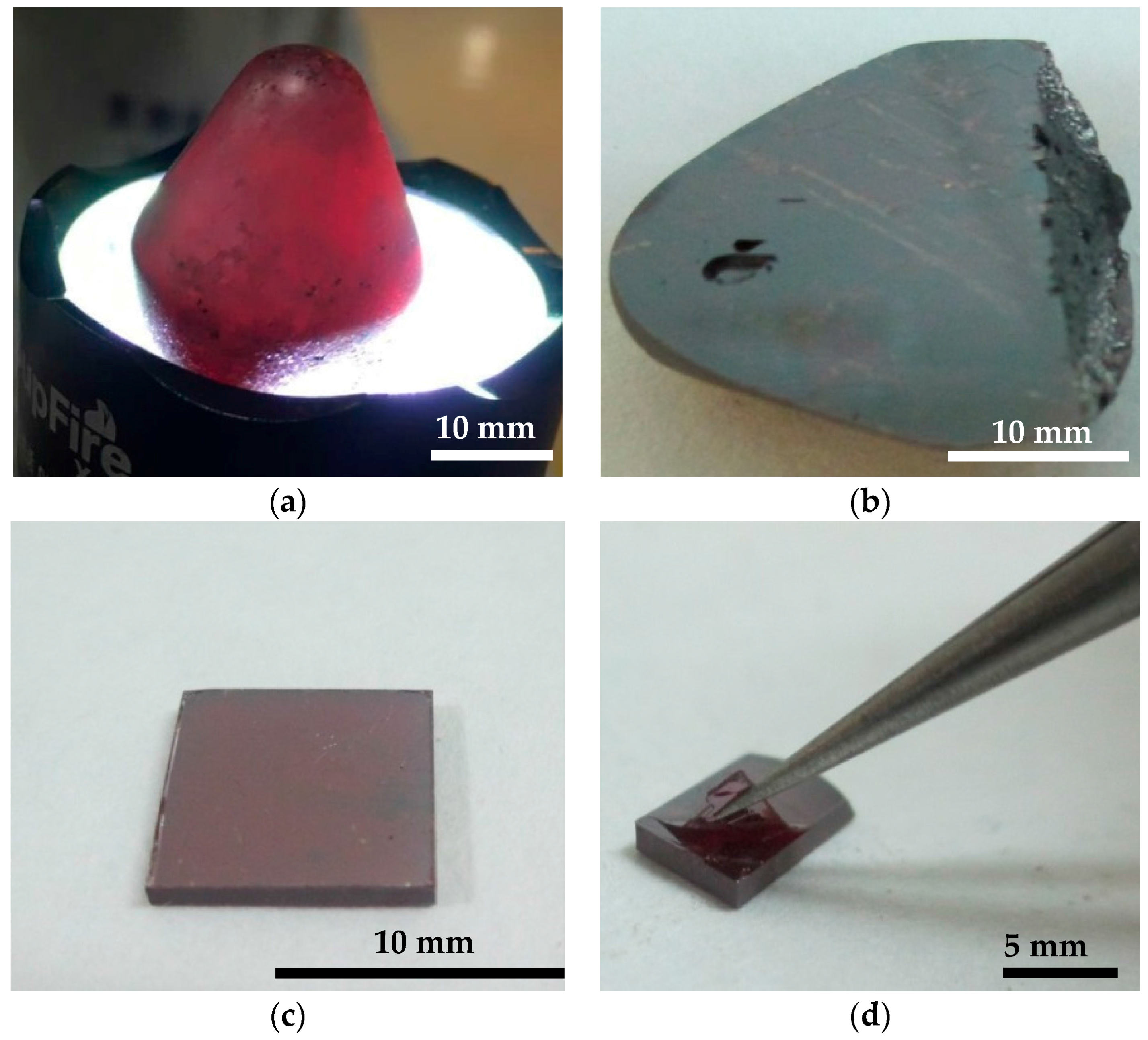
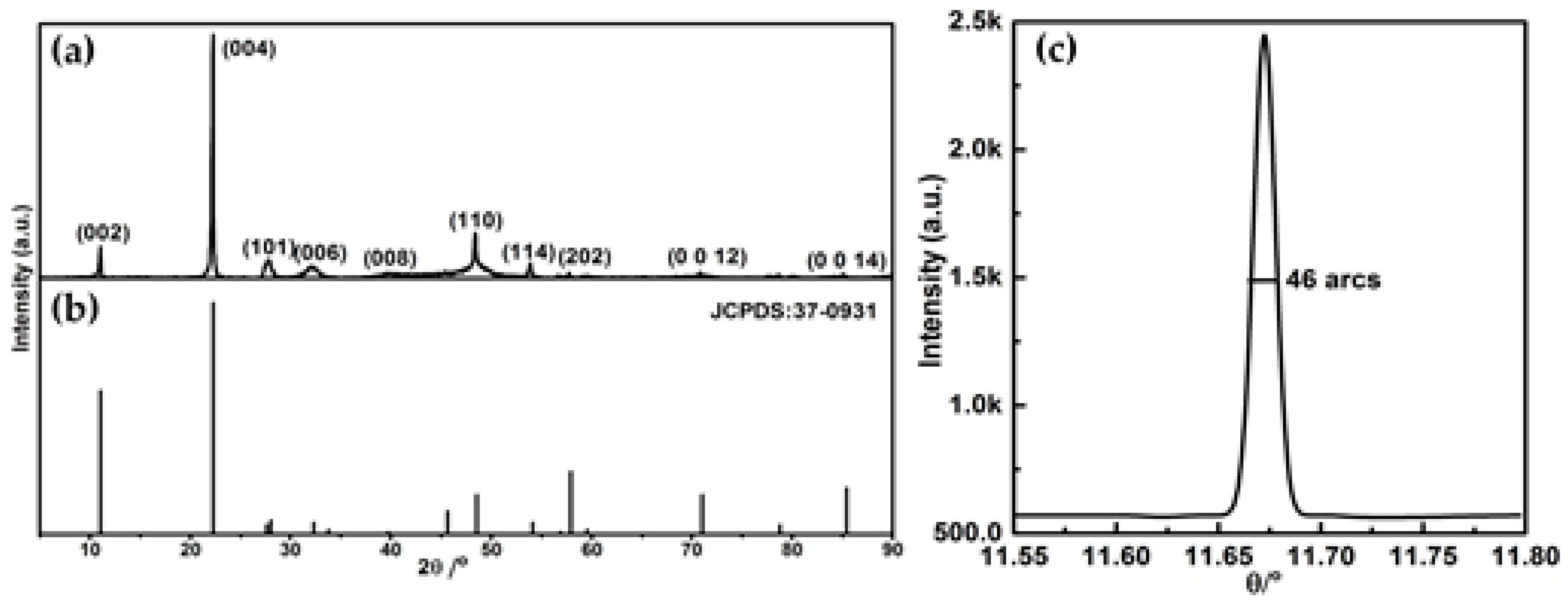

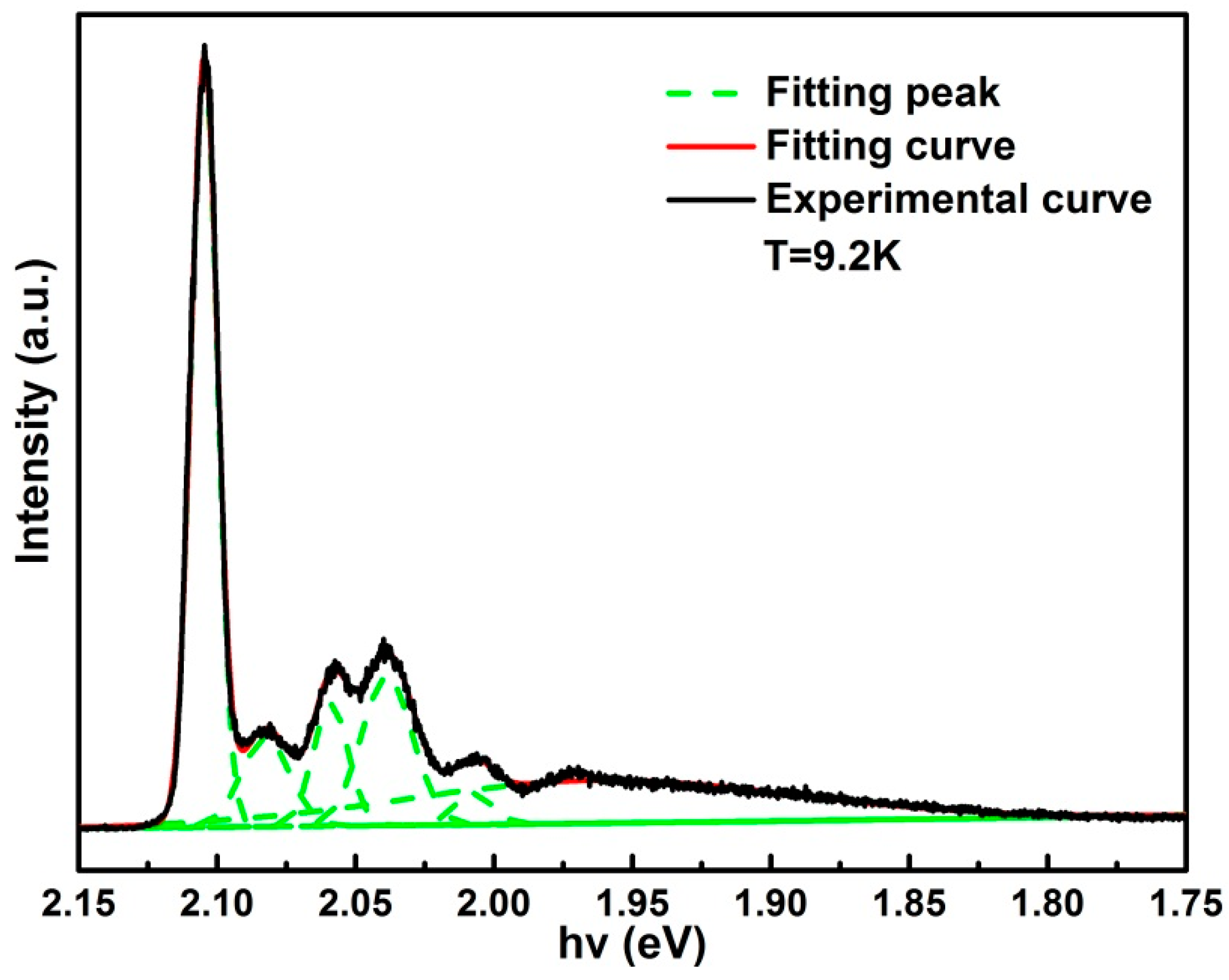
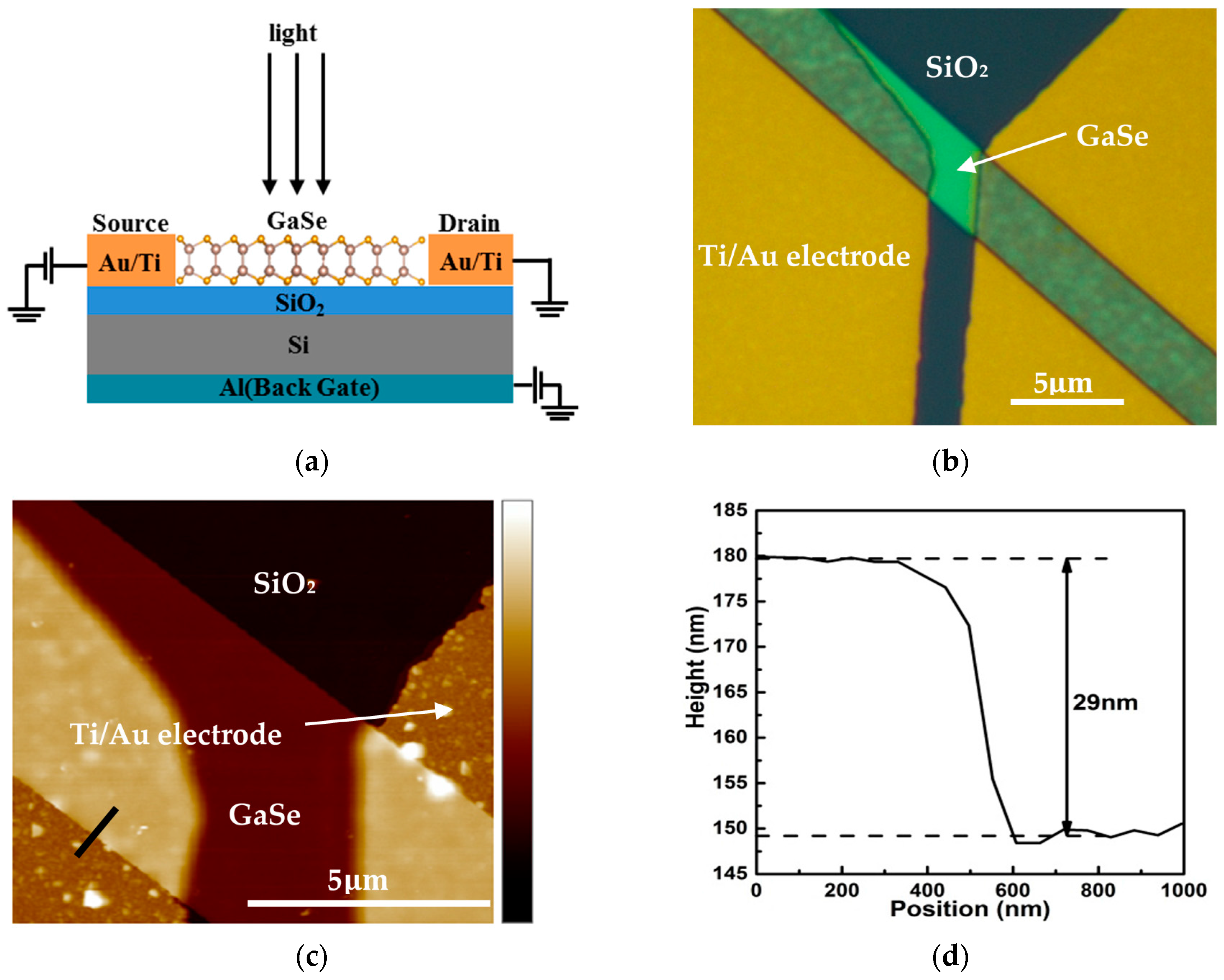
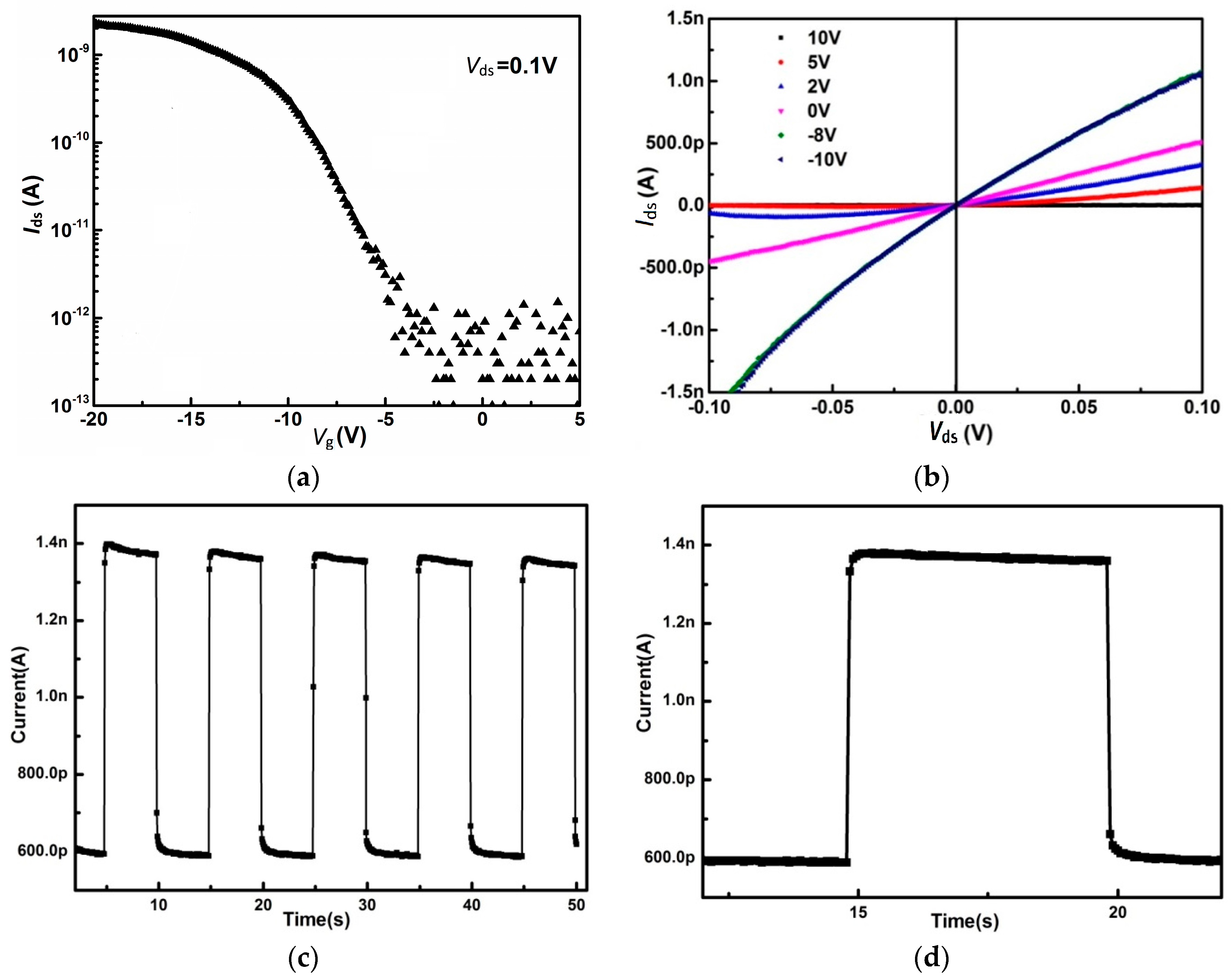
| Sample | Se (Atom %) | Ga (Atom %) |
|---|---|---|
| 1 | 49.5613 | 50.4387 |
| 2 | 49.5203 | 50.4797 |
| 3 | 49.6189 | 50.3811 |
| 4 | 49.5266 | 50.4734 |
| Sample | Conductivity Type | Carrier Concentration (cm−3) | Resistivity (Ω·cm) | Mobility (cm2 V−1 s−1) |
|---|---|---|---|---|
| 1 | p | 2.9894 × 1015 | 1.129546 × 102 | 1.8484 × 101 |
| 2 | p | 1.4701 × 1015 | 2.332230 × 102 | 1.8204 × 101 |
| 3 | p | 1.6830 × 1015 | 1.621991 × 102 | 2.3492 × 101 |
© 2018 by the authors. Licensee MDPI, Basel, Switzerland. This article is an open access article distributed under the terms and conditions of the Creative Commons Attribution (CC BY) license (http://creativecommons.org/licenses/by/4.0/).
Share and Cite
Wang, T.; Li, J.; Zhao, Q.; Yin, Z.; Zhang, Y.; Chen, B.; Xie, Y.; Jie, W. High-Quality GaSe Single Crystal Grown by the Bridgman Method. Materials 2018, 11, 186. https://doi.org/10.3390/ma11020186
Wang T, Li J, Zhao Q, Yin Z, Zhang Y, Chen B, Xie Y, Jie W. High-Quality GaSe Single Crystal Grown by the Bridgman Method. Materials. 2018; 11(2):186. https://doi.org/10.3390/ma11020186
Chicago/Turabian StyleWang, Tao, Jie Li, Qinghua Zhao, Ziang Yin, Yinghan Zhang, Bingqi Chen, Yong Xie, and Wanqi Jie. 2018. "High-Quality GaSe Single Crystal Grown by the Bridgman Method" Materials 11, no. 2: 186. https://doi.org/10.3390/ma11020186





